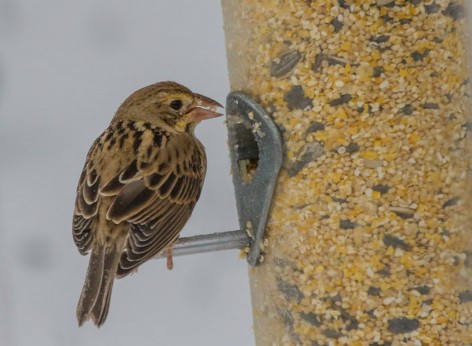Wayne R. Petersen

Photo by David Larson.
This month readers are faced with identifying a seed-eating species, specifically one that is not opposed to visiting bird feeders. “At a Glance,” the unidentified seed-eater looks pretty much like some of the birds possibly visiting your own backyard feeder. But as most birders know, birds are not always what they may at first appear to be – but sometimes they are! To reference the familiar medical school (and birding) maxim: “When you hear hoof beats, think horses not zebras” may apply here, but perhaps not!
A careful look at the pictured species suggests that it is likely a sparrow of some sort based on its somewhat undistinguished back and wing pattern, the pointy aspect of its tail, and most importantly the conical shape of its bill. It gives no indication of having wing-bars, nor is there a suggestion of white in the tail. A close look at the bird’s face reveals the presence of a black mark below the bill which is a partial view of a malar stripe (i.e., a jaw stripe similar to markings exhibited by Song Sparrows and a number of other sparrow species). This marking is actually important in identifying this mystery species.
Given the somewhat non-descript appearance of the back other than the clear, contrasting pale braces contrasting with darker stripes, there is little to use there that is helpful to the identification process. The dorsal view does however provide a clear look at the length of the mystery bird’s primaries – a feature that may be relevant to the identification process. With the above facts in mind, the head and bill ultimately offer the best clues to identification. There are only two regularly occurring species in Massachusetts that bear a resemblance to the mystery bird, female House Sparrow and Dickcissel, both of which are species that regularly visit bird feeders.
With the House Sparrow and Dickcissel as likely identification candidates, several of the observable features in the photograph are now significant. First, the bill. The mystery bird’s bill is clearly sharp-pointed and relatively long, not stout and blunt-tipped like that of a House Sparrow. Second, House Sparrows lack a malar stripe and are clear-breasted from chin to the belly, unlike Dickcissels which have a clear malar stripe in any plumage. And finally, Dickcissels are long-distance migrants possessing relatively long wings, while House Sparrows are essentially short-winged and sedentary and have an overall plumper appearance than Dickcissels. Even though the mystery bird gives no hint of its distinctive ventral pattern or coloration, after thoughtful examination the features described above are sufficient to identify the bird as a Dickcissel (Spiza americana).
Dickcissels are relatively rare in spring in Massachusetts, but are uncommon fall migrants, especially in weedy fields and gardens near the coast, and a few regularly overwinter at feeders, often in company with House Sparrows. David Larson photographed the mystery Dickcissel at his feeder in Bradford during the fall of 2015.
Wayne R. Petersen